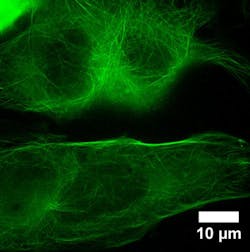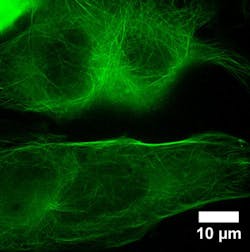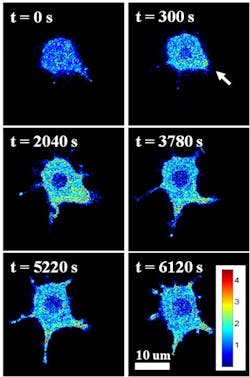New biosensor provides spatially resolved hydrogen peroxide sensing in cells
By attaching a hydrogen peroxide reporter protein to cellular microtubule structures, researchers at the Georgia Institute of Technology (Georgia Tech; Atlanta, GA) developed a biosensor able to show the location of the key cellular signaling chemical inside living cells with high resolution over time.
Related: Molecular disguises allow in vivo light activation of signaling peptides
Knowing the precise location of hydrogen peroxide within cells could help scientists gain a better understanding of oxidation-reduction reactions taking place there. The biosensor, known as HyPer-Tau, has utility in several applications because of its ability to spatially resolve the chemical's presence inside cells. It modifies a commercially available protein that alters its fluorescence properties in the presence of hydrogen peroxide.
Previously, hydrogen peroxide sensors could only tag certain components of cells, or show that the cells contained the oxidant. To understand the role of hydrogen peroxide in signaling and oxidation, however, the researchers wanted to know the time-resolved location of the chemical.
"We needed a tool that could discriminate between locations to provide more than a whole readout of oxidation," said Melissa Kemp, an associate professor in the Wallace H. Coulter Department of Biomedical Engineering at Georgia Tech and Emory University. "With very specific spatial information, we could be better informed about how cellular processes or therapies involving oxidation are going to operate."
Kemp and Christine Payne, an associate professor in the Georgia Tech School of Chemistry and Biochemistry and one of the paper's senior authors, realized that if they could anchor the reporter protein to microtubules, they might obtain the location information they needed.
Other researchers had already created variants of the HyPer reporter protein, so the researchers--with technician Emilie Warren, undergraduate researcher Tatiana Netterfield, and postdoctoral researcher Saheli Sarkar--set out to create a new tool. They added a tubulin-binding protein known as Tau, that connects the HyPer protein to the microtubule structures. Fluorescence microscopy then allowed them to observe the real-time change in fluorescence as oxidation occurred in the cells they were studying.
"Connecting the reporter protein allows us to get a grid-type readout of oxidation going on inside the cells," Kemp says. "By having the protein tethered, we can get very specific subcellular information. You can readily see areas with more intense oxidation."
Kemp and Payne have already used the tool to visualize the signaling process that takes place as macrophages discover bacteria and move to engulf and destroy the invaders.
"When the macrophages are activated, they begin shooting out tiny leg-like structures that seek the bacterial signal," explained Kemp. "To do so, they require hydrogen peroxide to control the migration and other activities. We can see in these leading edges where the oxidation is occurring inside the cells, providing an unprecedented view of the behavior."
By combining multiple images, the researchers produced movies correlating the production of hydrogen peroxide to the activities of the immune system cells. In another application, the biosensor was used to study how cells respond to the introduction of extracellular hydrogen peroxide, which produces a wave of oxidation as it moves through the cellular structures.
"This provides a way to quantify both intracellular and intercellular variation that is occurring," Kemp explains. "Our goal is to be able to monitor in real-time the events that are occurring. Because of the spectral features of the reporter, you can couple this with other types of dyes to monitor organelles and different types of production."
Kemp hopes to use the new sensor to better understand oxidation of another type of immune cell, T cells, as they form contact with other cells to recognize the presence of viruses. In studies that could be important to understanding the effects of nanoscale materials on living cells, the researchers are working to understand the suspected oxidative impacts of titanium dioxide nanoparticles. The new technique could also be useful in understanding how stem cells change oxidation properties during differentiation into other cell types.
In current research, Netterfield is working with Kemp and Payne to combine the existing technique with other reporter proteins to gain additional information.
Once thought to be a sign of disease processes, hydrogen peroxide is now understood to be a critical signaling chemical inside cells, Kemp notes. Cells purposely produce the chemical, which can quickly oxidize proteins to alter their functions. Hydrogen peroxide is also generated at sites of inflammation, and as macrophages destroy pathogens.
Full details of the work appear in the journal Scientific Reports; for more information, please visit http://dx.doi.org/10.1038/srep16929.
Follow us on Twitter, 'like' us on Facebook, connect with us on Google+, and join our group on LinkedIn


